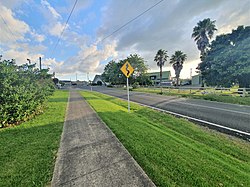Hūnua
Hūnua | |
|---|---|
 | |
 | |
| Coordinates: 37°04′42″S 175°04′17″E / 37.0783°S 175.0714°E | |
| Country | New Zealand |
| Region | Auckland Region |
| Ward | Franklin ward |
| Board | Franklin Local Board |
| Electorates | |
| Government | |
| • Territorial Authority | Auckland Council |
| Area | |
| • Total | 77.83 km2 (30.05 sq mi) |
| Population (June 2023)[2] | |
| • Total | 1,530 |
| • Density | 20/km2 (51/sq mi) |
Hūnua (Māori pronunciation: [hʉˈnʉa]) is a small settlement in the rural outskirts of south Auckland, New Zealand.
Hūnua is 14 kilometres (8.7 mi) east of Papakura,[3] 3.6 kilometres (2.2 mi) from Hūnua Falls and lies at the foot of the Hunua Ranges, from where Auckland obtains most of its water supply.[4] The literal translation of the Māori language word is 'mountainous and sterile land'.[3]
Demographics
Hūnua statistical area covers 77.83 km2 (30.05 sq mi)[1] and had an estimated population of 1,530 as of June 2023,[2] with a population density of 20 people per km2.
| Year | Pop. | ±% p.a. |
|---|---|---|
| 2006 | 1,107 | — |
| 2013 | 1,155 | +0.61% |
| 2018 | 1,353 | +3.22% |
| Source: [5] | ||
Hūnua had a population of 1,353 at the 2018 New Zealand census, an increase of 198 people (17.1%) since the 2013 census, and an increase of 246 people (22.2%) since the 2006 census. There were 444 households, comprising 669 males and 684 females, giving a sex ratio of 0.98 males per female. The median age was 42.6 years (compared with 37.4 years nationally), with 273 people (20.2%) aged under 15 years, 216 (16.0%) aged 15 to 29, 708 (52.3%) aged 30 to 64, and 156 (11.5%) aged 65 or older.
Ethnicities were 94.2% European/Pākehā, 10.2% Māori, 2.2% Pacific peoples, 2.4% Asian, and 1.6% other ethnicities. People may identify with more than one ethnicity.
The percentage of people born overseas was 20.0, compared with 27.1% nationally.
Although some people chose not to answer the census's question about religious affiliation, 58.1% had no religion, 32.2% were Christian, 0.2% had Māori religious beliefs, 0.4% were Hindu, 0.2% were Muslim and 1.6% had other religions.
Of those at least 15 years old, 234 (21.7%) people had a bachelor's or higher degree, and 135 (12.5%) people had no formal qualifications. The median income was $45,800, compared with $31,800 nationally. 324 people (30.0%) earned over $70,000 compared to 17.2% nationally. The employment status of those at least 15 was that 663 (61.4%) people were employed full-time, 177 (16.4%) were part-time, and 24 (2.2%) were unemployed.[5]
Education
Hūnua School is a coeducational full primary school (years 1–8) with a roll of 127 as of February 2024.[6][7] The school was founded in 1876.[8]
References
- ^ a b "ArcGIS Web Application". statsnz.maps.arcgis.com. Retrieved 8 January 2024.
- ^ a b "Population estimate tables - NZ.Stat". Statistics New Zealand. Retrieved 25 October 2023.
- ^ a b Reed, A. W. (2010). Peter Dowling (ed.). Place Names of New Zealand. Rosedale, North Shore: Raupo. p. 177. ISBN 9780143204107.
- ^ Waterhouse, Barry Clayton (22 April 2009) [First published in 1966]. "Hunua Ranges". In McLintock, A. H. (ed.). An Encyclopaedia of New Zealand. Ministry for Culture and Heritage / Te Manatū Taonga. Retrieved 20 May 2015.
- ^ a b "Statistical area 1 dataset for 2018 Census". Statistics New Zealand. March 2020. Hunua (165200). 2018 Census place summary: Hunua
- ^ "New Zealand Schools Directory". New Zealand Ministry of Education. Retrieved 14 March 2024.
- ^ Education Counts: Hunua School
- ^ Hunua School Centennial, 1876-1976; a Brief History of the Hunua School and Surrounding District. Hunua School Centennial and District Re-Union Committee. 1976.
Further reading
- Barton, Ian (2001). Hunua: the Place and Its People: a View from 2000. W. J. Deed Printing. ISBN 0-473-07474-5.
External links
- Photographs of Hūnua held in Auckland Libraries' heritage collections.
- Use dmy dates from August 2015
- Use New Zealand English from August 2015
- All Wikipedia articles written in New Zealand English
- Articles with short description
- Short description is different from Wikidata
- Infobox mapframe without OSM relation ID on Wikidata
- Coordinates on Wikidata
- Pages with plain IPA
- Populated places in the Auckland Region
- Franklin Local Board Area
- Pages using the Kartographer extension